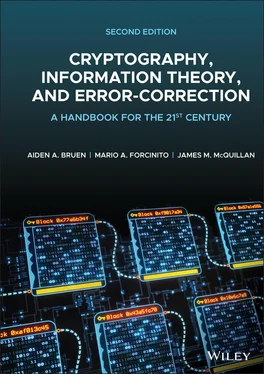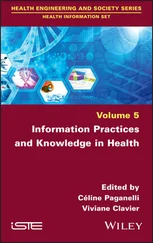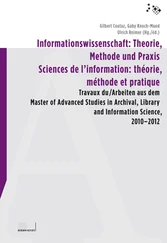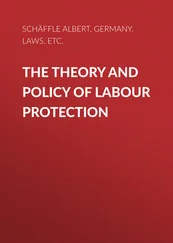Aiden A. Bruen - Cryptography, Information Theory, and Error-Correction
Здесь есть возможность читать онлайн «Aiden A. Bruen - Cryptography, Information Theory, and Error-Correction» — ознакомительный отрывок электронной книги совершенно бесплатно, а после прочтения отрывка купить полную версию. В некоторых случаях можно слушать аудио, скачать через торрент в формате fb2 и присутствует краткое содержание. Жанр: unrecognised, на английском языке. Описание произведения, (предисловие) а так же отзывы посетителей доступны на портале библиотеки ЛибКат.
- Название:Cryptography, Information Theory, and Error-Correction
- Автор:
- Жанр:
- Год:неизвестен
- ISBN:нет данных
- Рейтинг книги:5 / 5. Голосов: 1
-
Избранное:Добавить в избранное
- Отзывы:
-
Ваша оценка:
- 100
- 1
- 2
- 3
- 4
- 5
Cryptography, Information Theory, and Error-Correction: краткое содержание, описание и аннотация
Предлагаем к чтению аннотацию, описание, краткое содержание или предисловие (зависит от того, что написал сам автор книги «Cryptography, Information Theory, and Error-Correction»). Если вы не нашли необходимую информацию о книге — напишите в комментариях, мы постараемся отыскать её.
A rich examination of the technologies supporting secure digital information transfers from respected leaders in the field Cryptography, Information Theory, and Error-Correction: A Handbook for the 21ST Century
Cryptography, Information Theory, and Error-Correction
Cryptography, Information Theory, and Error-Correction — читать онлайн ознакомительный отрывок
Ниже представлен текст книги, разбитый по страницам. Система сохранения места последней прочитанной страницы, позволяет с удобством читать онлайн бесплатно книгу «Cryptography, Information Theory, and Error-Correction», без необходимости каждый раз заново искать на чём Вы остановились. Поставьте закладку, и сможете в любой момент перейти на страницу, на которой закончили чтение.
Интервал:
Закладка:
Chapter 26features a simple new proof of the security of Bitcoin in the matter of double spending, avoiding the assumptions of the approximation by a continuous random variable in the original paper by Nakamoto ([Nak08]).
Chapter 27discusses privacy and security concerns relating to the Internet of Things (IoT). Important questions include: Who has access to the information that your smart device is collecting? Could someone remotely access your smart device?
Chapter 28focuses on the availability of data stored in the cloud and on homomorphic encryption, which allows computations to be done on data while it is in an encrypted form.
Chapter 29features another approach to MDS codes and, we hope, a very interesting discussion of the venerable topic of mutually orthogonal latin squares. There are also exercises in modular arithmetic, finite fields, linear algebra, and other topics to elucidate theoretical results in previous chapters, along with solutions.
Hardcover and eBook
The second edition will be available both as a hardcover book and as an eBook. The content will be the same in both. Besides traditional formatting for items in the bibliography, most of the items have accompanying URLs.
The eBook will have clickable links, including links to chapter and section numbers, to theorem numbers, from problems to their solutions, and to items in the bibliography. The URLs in the bibliography will also be clickable in the eBook.
Numbering of Definitions, Examples, Results.
When referring to a definition or result, we list the chapter number, a dot and then a number from an increasing counter for that chapter. For instance, Example 10.7 is the seventh numbered item in Chapter 10. Theorem 10.8 comes after Example 10.7 and is the eight such numbered item in Chapter 10.
Numbering of Problems, Solutions.
Most chapters have a section called Problems followed immediately by a corresponding section called Solutions at the end of the chapter. Problems and Solutions at the end of the chapter have their own counters. So, Problem 10.6 is the sixth problem in the Problems section (Section 10.15) of Chapter 10and Solution 10.6 has the solution to that problem. It can be found in the subsequent section (Section 10.16).
Numbering of Equations.
Equation numbers follow their own counter for each chapter. For example, Equation (9.7) is the seventh equation in Chapter 9.
Acknowledgments for the Second Edition
The third author is extremely grateful to the first two authors for inviting him to be a co‐author on the second edition! Thank you so much!
We are extremely grateful to a few individuals for their help with the second edition. We thank Professor Dan McQuillan from the Department of Mathematics at Norwich University in Vermont for a careful reading and many improvements to many chapters in the second edition. We thank Joy McQuillan for a careful reading and improvements to several chapters. We are indebted to Professor Sumesh Philip from the School of Information Technology at Illinois State University in Illinois for many significant improvements to the new content in the second edition. We thank Professor David Wehlau of the Department of Mathematics and Computer Science at the Royal Military College of Canada and the Department of Mathematics and Statistics at Queen's University in Kingston, Canada for valuable comments. We also thank Dr. Valery Ipatov from Petersburg State Electrotechnical University in Russia for numerous corrections to the first edition, and Burt Wilsker for corrections to the first edition. These were incorporated into the second edition.
We thank the Wiley staff including Kimberly Monroe‐Hill, Kathleen Pagliaro, Blesy Regulas, Linda Christina E, Mindy Okura‐Marszycki, and Kathleen Santoloci for their help with the second edition. We also thank Wiley staff Gayathree Sekar, Becky Cowan, and Aileen Storry.
Book Website
The website for the book is
http://cryptohandbook.info
It will be a repository for additional information and updates.
We have done our best to correct the errors but, inevitably, some will remain. We invite our readers to submit errors to mario@cryptohandbook.info. We will post them, with attribution, on the website along with other clarifications as they arise.
About the Authors
Aiden A. Bruen was born in Galway, Ireland. He read mathematics for his Undergraduate and Master's degree in Dublin and received his Doctorate at the University of Toronto, supervised by F.A. Sherk. At Toronto, he also worked with H.S.M. Coxeter, E. Ellers, and A. Lehman. Dr. Bruen is an Adjunct Research Professor at Carleton University and a Professor Emeritus at the University of Western Ontario.
Mario A. Forcinito was born in Buenos Aires, Argentina where he took his Bachelor's degree in Engineering. He obtained his doctorate in Engineering at the University of Calgary under the supervision of M. Epstein. Dr. Forcinito is the CTO of AP Dynamics , an engineering company in Calgary. He currently holds an Adjunct Professor position at the Schulich School of Engineering, University of Calgary and is an industrial engineering consultant in the energy area in Calgary.
James M. McQuillan grew up in Ottawa, Canada. He obtained his Undergraduate and Master's degrees from Carleton University in Ottawa and the University of Vermont and his doctorate from the University of Western Ontario (now Western University) in London, Canada. Dr. McQuillan is a Professor in the School of Computer Sciences at Western Illinois University.
Chapter 1 Historical Introduction and the Life and Work of Claude E. Shannon
Goals, DiscussionWe present here an overview of historical aspects of classical cipher systems. Our objective is to give the reader a panoramic view of how the fundamental ideas and important developments fit together. This overview does not pretend to be exhaustive but gives a rough time line of development of the milestones leading to modern cryptographic techniques. The reader interested in a complete historical review is advised to consult the definitive treatise by Kahn [Kah67].
1.1 Historical Background
Cryptology is made up of two Greek words kryptos , meaning “hidden,” and lógos meaning “word.” It is defined [Bri19] as the science concerned with data communication and storage in secure and usually secret form. It encompasses both cryptography (from the Greek graphia meaning writing) and cryptanalysis or the art of extracting the meaning of a cryptogram.
Cryptography has a history that is almost as long as the history of the written word. Some four millennia ago (see [Kah67, p. 71]), an Egyptian scribe recorded in stone the first known hieroglyphic symbol substitution in the tomb of Khnumhotep II , a nobleman of the time. Although the intention in this case was to exalt the virtues of the person, rather than to send a secret message, the scribe used for the first time one of the fundamental elements used by cryptographers throughout the ages, namely substitution. He used unusual hieroglyphic symbols, known perhaps only to the elite, in place of the more common ones.
In substitution, the sender replaces each letter of a word in a message by a new letter (or sequence of letters or symbols) before sending the message. The recipient, knowing the formula used for the substitution – the secret key– is able to reconstruct the message from the scrambled text that was received. It is assumed that only the recipient and the sender know the secret key.
Читать дальшеИнтервал:
Закладка:
Похожие книги на «Cryptography, Information Theory, and Error-Correction»
Представляем Вашему вниманию похожие книги на «Cryptography, Information Theory, and Error-Correction» списком для выбора. Мы отобрали схожую по названию и смыслу литературу в надежде предоставить читателям больше вариантов отыскать новые, интересные, ещё непрочитанные произведения.
Обсуждение, отзывы о книге «Cryptography, Information Theory, and Error-Correction» и просто собственные мнения читателей. Оставьте ваши комментарии, напишите, что Вы думаете о произведении, его смысле или главных героях. Укажите что конкретно понравилось, а что нет, и почему Вы так считаете.












